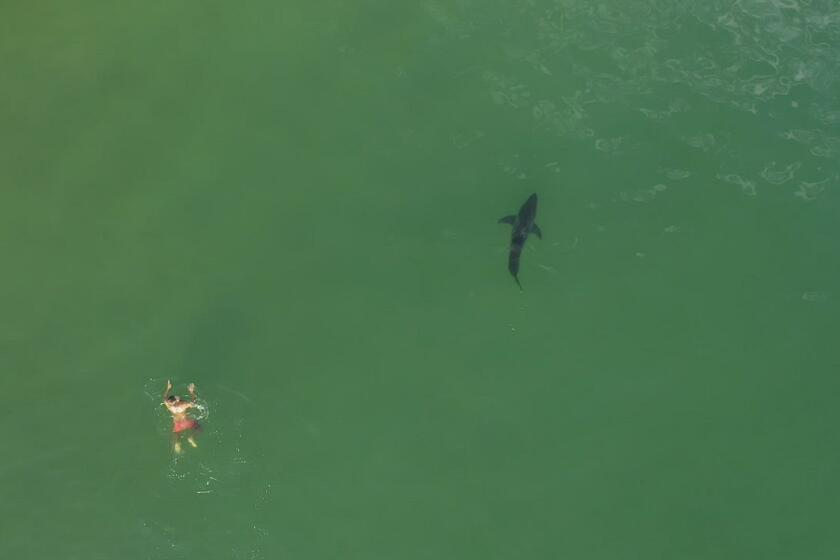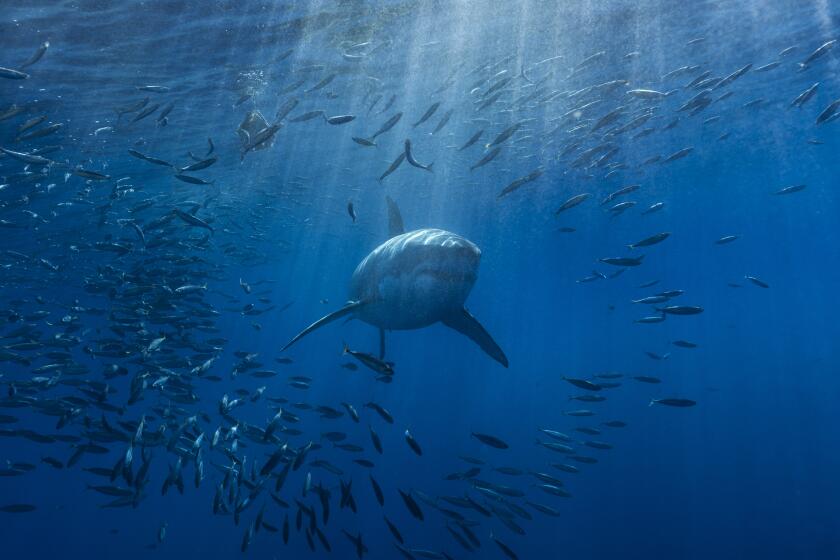Great white sharks more common off California coast than previously thought, study says

- Share via
If you swam off the coast of Santa Barbara or San Diego recently, chances are you had company. You just may not have noticed.
A new study from Cal State Long Beach found that juvenile white sharks are more common at some California beaches than previously thought.
Although the news may conjure up images of Steven Spielberg’s film “Jaws,” scientists say it should instead be a reminder of how rare shark bites are.
“It’s not just about sharks, it’s about people,” Christopher Lowe, professor of marine biology at Cal State Long Beach and director of the school’s Shark Lab, said in a statement. “This study may change people’s perception of the risk sharks pose to people that share the ocean with them.”
This Malibu photographer captures images of great white sharks along the Southern California coast, many just feet from unknowing swimmers and surfers.
During the two-year study, researchers used drones to study more than two dozen beaches up and down the California coastline.
Juvenile white sharks, between the ages of 1 and 5, were found congregating at two spots in southern Santa Barbara County and central San Diego County.
At those locations, sharks and people were found swimming together 97% of the time, according to findings released Friday.
“The juvenile white sharks were often observed within 50 yards of where the waves break, putting surfers and stand-up paddle boarders in the closest proximity to sharks at the aggregation sites,” Patrick Rex, a lab technician at the Shark Lab, said in a statement. “Most of the time water users didn’t even know the sharks were there, but we could easily see them from the air.”
In an interview with The Times, Rex called the findings surprising.
“People think, ‘If I see a shark in the lineup (the area where waves begin breaking), I’m going to get bitten or I’m in danger.’” Rex said. “And what we’ve seen is that that’s not necessarily the case.”
The fish “tend to mind their own business,” Rex said.
“And they come up within like 10 feet of people, and that’s happening daily,” he said. “What we found is that they’re spending the majority of their time within 100 yards of where the waves are breaking.”
That’s a lot closer than originally thought.
“It was assumed that sharks are miles out but you could be wading and then have a shark swim right next to you,” he said.
No shark bites were reported at any of the beaches observed during the two-year survey. From 1950 to November 2022, there were 209 documented shark incidents in California, according to the state Department of Fish and Wildlife.
These new data can be used by lifeguards, especially those at aggregation spots, to help ensure safe swimming and water recreation, Lowe said.
The young sharks gather in the aggregation spots for several years, feasting on stingrays and small fish on the seafloor.
The Monterey Bay Aquarium tracked 79 juvenile sharks and found great whites have not only adapted to the perils of climate change, but thrived in them.
Exactly why sharks are so disinterested in snacking on humans is still a mystery, Rex said. Even when hunting, they tend to ignore what’s going on at the surface.
Rex and Lowe have hypothesized that the sharks have started to identify humans as “not food.”
“But that’s such a hard conclusion to make, because we still don’t really know why sharks bite people,” Rex said.
Still, humans do not appear to be on the menu.
That may be a blessing as it appears that the fish may be staying along the California coastline for longer periods of time.
“What we’ve been telling people for the past 20 years is that the sharks will be here for the summertime and then, when our water gets too cold, they migrate down to Mexico,” Rex said.
Cal State Long Beach’s Shark Lab says the number of sharks off Southern California has grown. Rather than migrating to Baja, they’re ‘sticking around.’
But the study found some sharks never left.
Climate change and warmer waters could be the reason, Rex said.
“It means that the sharks may not be making that long migration anymore,” Rex said. “But we need more data and more time to make any conclusions on that.”
More to Read
Sign up for Essential California
The most important California stories and recommendations in your inbox every morning.
You may occasionally receive promotional content from the Los Angeles Times.













